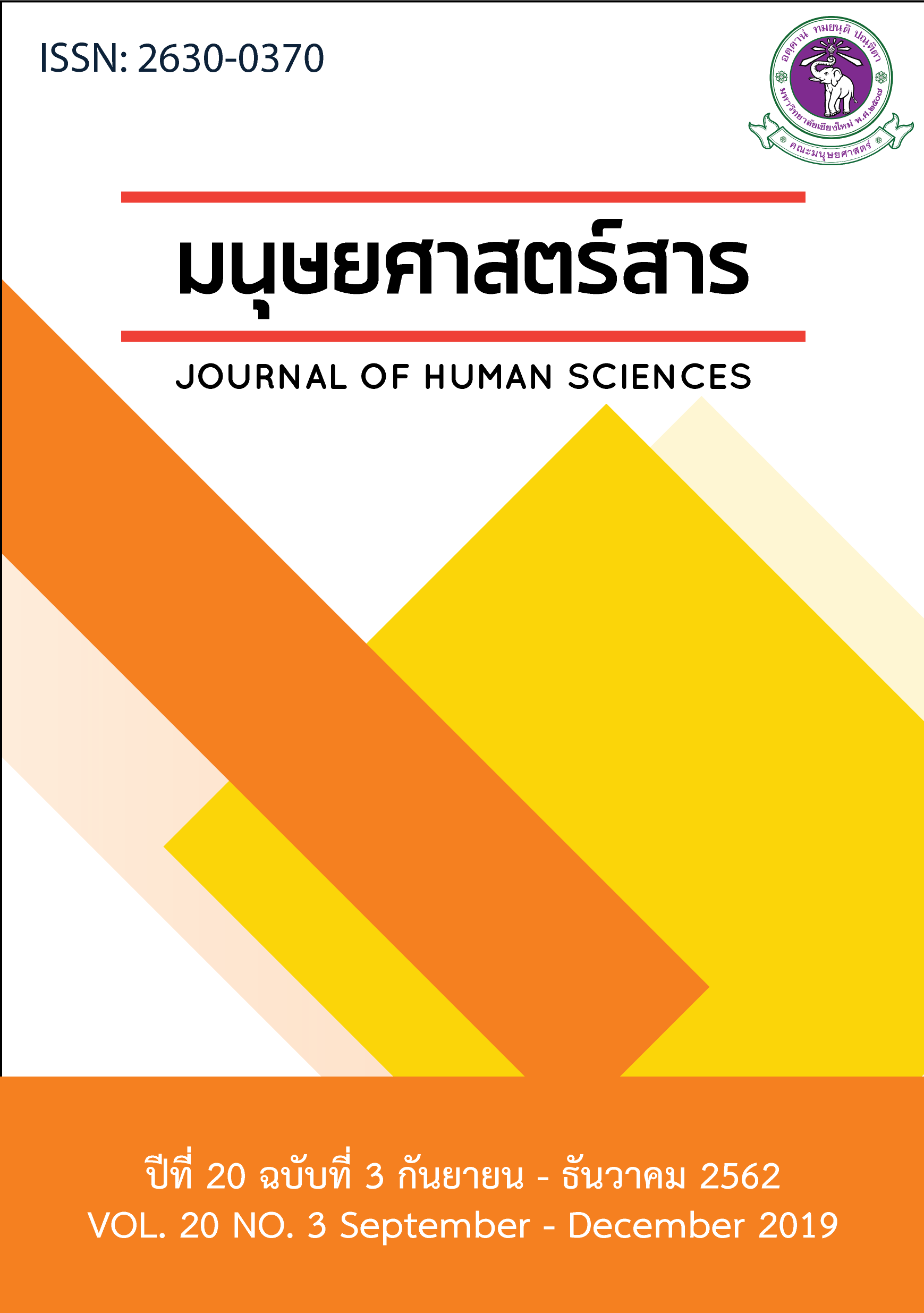การเพิ่มประสิทธิภาพองค์ประกอบของโลจิสติกส์ด้านการท่องเที่ยวในจังหวัดพระนครศรีอยุธยา
Main Article Content
บทคัดย่อ
การวิจัยนี้มีวัตถุประสงค์ เพื่อศึกษาพฤติกรรมการท่องเที่ยวของนักท่องเที่ยวชาวไทยในจังหวัดพระนครศรีอยุธยา ศึกษาระดับประสิทธิภาพขององค์ประกอบของโลจิสติกส์ด้านการท่องเที่ยวในจังหวัดพระนครศรีอยุธยาในมุมมองของนักท่องเที่ยว และศึกษาแนวทางในการเพิ่มประสิทธิภาพองค์ประกอบของโลจิสติกส์ด้านการท่องเที่ยวในจังหวัดพระนครศรีอยุธยา ใช้ระเบียบวิธีวิจัยแบบผสมผสานโดยการวิจัยเชิงคุณภาพใช้วิธีการสัมภาษณ์เชิงลึกผู้ประกอบการด้านการท่องเที่ยวจำนวน 5 ราย และเจ้าหน้าที่ภาครัฐที่เกี่ยวข้องจำนวน 3 ราย ส่วนการวิจัยเชิงปริมาณเก็บข้อมูลจากนักท่องเที่ยวจำนวน 400 ราย โดยใช้แบบสอบถาม สถิติในการประมวลข้อมูล ได้แก่ ค่าร้อยละ ค่าเฉลี่ย และส่วนเบี่ยงเบนมาตรฐาน สถิติเชิงอ้างอิง ได้แก่ t-test, ANOVA วิเคราะห์ความแตกต่างเป็นรายคู่ด้วย Scheffé กำหนดนัยสำคัญทางสถิติที่ระดับ .05 ผลการวิจัยพบว่า นักท่องเที่ยวส่วนใหญ่เป็นเพศหญิง อายุ 25-29 ปี สถานภาพโสด อาชีพพนักงานบริษัท รายได้เฉลี่ยต่อเดือนน้อยกว่า 25,000 บาท การศึกษาปริญญาตรี มาท่องเที่ยว 2–4 ครั้งต่อปี ใช้เวลา 2–4 วันต่อครั้ง ผู้ร่วมเดินทาง 2–3 คน ได้รับข่าวสารจากเพื่อนและญาติ เดินทางโดยรถยนต์ส่วนตัว ค่าใช้จ่ายต่อครั้ง 3,000–5,000 บาท วัตถุประสงค์หลักเพื่อพักผ่อน ระดับประสิทธิภาพขององค์ประกอบของโลจิสติกส์ด้านการท่องเที่ยวในมุมมองของนักท่องเที่ยวในเขตพื้นที่จังหวัดพระนครศรีอยุธยา พบว่า อยู่ในระดับปานกลาง 2 ด้าน ได้แก่ คุณค่าที่ได้รับจากการจัดการ โลจิสติกส์ด้านการไหลทางกายภาพ และด้านการไหลของสารสนเทศ ในขณะที่ด้านการให้บริการอยู่ในระดับมาก การเปรียบเทียบความแตกต่างของความคิดเห็นต่อประสิทธิภาพขององค์ประกอบของโลจิสติกส์ในด้านการท่องเที่ยวจำแนกตามเพศ พบความแตกต่าง
1 รายการ ได้แก่ ด้านกายภาพ จำแนกตามอายุ พบความแตกต่าง 1 รายการ ได้แก่ ด้านการให้บริการ จำแนกตามสถานภาพสมรส ภาพรวมมีความแตกต่างกัน เมื่อพิจารณารายด้านพบความแตกต่าง 2 รายการ ได้แก่ ด้านกายภาพและด้านการให้บริการ จำแนกตามอาชีพ พบความแตกต่าง 1 รายการ ได้แก่ ด้านการให้บริการ สำหรับแนวทางในการเพิ่มประสิทธิภาพขององค์ประกอบของโลจิสติกส์ด้านการท่องเที่ยวในจังหวัด พระนครศรีอยุธยา ในด้านคุณค่าที่ได้รับจากการไหลทางกายภาพ ต้องจัดการด้านยานพาหนะในการเดินทางไปยังแหล่งท่องเที่ยวให้สะดวกขึ้นและมีการจัดระบบการกำหนดราคาค่าบริการเดินทางที่เหมาะสมและเป็นธรรม เพิ่มรูปแบบการเดินทางให้มีความหลากหลายเหมาะสมกับสภาพภูมิประเทศและแหล่งท่องเที่ยวของจังหวัด ในด้านคุณค่าที่ได้รับจากองค์ประกอบของโลจิสติกส์ด้านการไหลของสารสนเทศ โดยเน้นแหล่งอาหาร ที่พักและมัคคุเทศก์ท้องถิ่น เพิ่มสื่อที่นักท่องเที่ยวสามารถเข้าถึงข้อมูลด้านการท่องเที่ยวได้ง่ายและสะดวก ปรับปรุงระบบข้อมูลการท่องเที่ยวผ่านศูนย์ข้อมูลภาครัฐและข้อมูลการท่องเที่ยวในแต่ละจุดท่องเที่ยวหลัก
Article Details
เอกสารอ้างอิง
Authayan C. (2017). Phrưttikamnakthongthiao. Retrieved from https://touristbehaviour.wordpress.com/1/
Ayutthaya Tourism and Sports Office. (2017). khormun kanthongthieo changwat Phra Nakhon Si Ayutthaya. Retrieved from https://ayutthaya.mots.go.th/
Bank of Thailand. (2017). Thailand Economic Report 2017. Retrieved from https://www.bot.or.th/Thai/MonetaryPolicy/EconomicConditions/AnnualReport/AnnualReport/AnnualReport2560.pdf
Bejrananda, T. (2016). raeng chungchai nai kandoenthang thongthieo yang laeng thongthieo choeng Niwet nai khet phưnthi kankha chaidaen changwat chiang raI [Travel Motivations for Visiting Ecotourism Destinations in Border Areas of Chiang Rai]. SUTHIPARITHAT journal, 30(94). 42-59.
Goossens, C. (2000). Tourism Information and Pleasure Motivation. Annals of Tourism Research. 27(2). 301-321.
Chaichan, T. (2012). kanchatkan lochittik kanthongthieo nai wang nam khieo changwat Nakhon Ratchasima [Tourism Logistics Management for Wang Nam Khiew district in Nakhon Ratchasima Province]. Suranaree Journal of Social Science (SJSS), 6(2). 17-33.
Charoonsrichotkhamjorn, V., Munha, S., Charoensuwan, K., Sripirom, K. Onched, P., Rambud, W., & Sangngam, C. (2017). prasitthiphap kanchatkan lochittik khong læng thongthieo changwat kamphæng phet [The Efficiency of Logistics Management for Tourist Attraction in Kamphaeng Phet Province]. Journal Modern Management Science, 10(2). 213-229.
Font, X., Tapper, R., Schwartz, K. & Kornilaki, M. (2008). Sustainable supply chain management in tourism, Business Strategy and the Environment, 17(4). 260–271.
Goossens, C. (2000). Tourism information and pleasure motivation. Annals of Tourism Research, 27(2). 301-321.
Ramkissoon, H., Weiler, B. & Smith, L. (2011). Place Attachment and Pro Environmental Behavior in National Park: The Development of a Conceptual Framework. Journal of Policy Research in Tourism Leisure and Events, 5(3). 215-232
Khamsri, R., Chuchuay, P., Phunphanasakul, J. & Kraisanti, K. (2016). phrưttikam læ ræng chungchai nai kanthongthieo chœng anurak boriwen khet phưnthi khlong dæn amphœ ranot changwat songkhla [Behavior and Motivation of Ecotourism at Klon-Dan, Ranod District, Songkhla] (Master’s thesis, HatYai University).
Khawsaad, M. & Suriya, K. (2008). kan wikhro lochittik dan kanthongthieo nai mưang thongthieo. Retrieved from http://www.tourismlogistics.com
Khawsaad, M. et al. (2008). kanphatthana kanthongthieo chœng buranakan thi yangyưn sam: kanpriapthiap chœng lochittik: Social Research Institute, Chiang Mai University
Lambert, D.M., Stock, J.R., & Ellram, L.M. (1998). Fundamentals of logistics management. Boston: Irwin/McGraw-Hill.
Lemmetyinen, A. (2010). Coordination of cooperation in tourism business networks (PhD thesis, Turku School of Economics, Turku).
Lue, C. C., Crompton, J. L., & Stewart, W. P. (1996). Evidence of Cumulative Attraction in Multidestination Recreational Trip Decisions. Journal of Travel Research, 35(1). 41–49.
Lumsdon, L & Page, S. (2004). Progress in transport and tourism research: Reformulating the transport-tourism interface and future research agendas?. In Les Lumsdon & Stephan Page (eds.). 2004. Tourism and Transport: Issues and Agenda for the New Millennium. London: Elsevier.
Ministry of Tourism and Sports. (2015). Thai Tourism Strategy 2015-2017. Retrieved from https://www.mots.go.th/ewt_dl_link.php?nid=7114
Moscardo, G., Morrison, A.M.; Pearce P.L.; Lang C.-T. & O’Leary J.T. (1996). Understanding Vacation Destination Choice Through Travel Motivation and Activities. Journal of Vacation Marketing, 2(2). 109-122.
Muller, H. (2001). Tourism and hospitality into the 21st Century. pp. 61-70. In Lockwood, Andrew & Medlik, S. (Eds). (2016). Tourism and hospitality in the 21st Century. Oxford: Butterworth-Heinemann.
Office of the National Economic and Social Development Board. (2017). Thailand Economic Report, 2017. Retrieved from http://www.nesdb.go.th/more_news.php?cid=383&filename=index
Pearce, P. L. (1988). The Ulysses Factor: Evaluating Visitors in Tourist Settings. New York: Springer Verlag.
Penchumrat. P., Songsaeng, S., & Khongyang, W. (2011). kansưksa næothang kanphatthana lochittik samrap kanthongthieo changwat song khla [Study on tourism logistics in Songkhla province: Research Project].
Retrieved from http://kb.psu.ac.th/psukb/handle/2010/8658
Piboonrongrote, P. (2012). næokhit lochittik kanthongthieo. Retrieved from https://www.facebook.com/drpairach/photos/a.349732838448365/598065900281723/?type=3&theater
Saninmool V. (2017). kanphatthana sakkayaphap lochittik kanthongthieo chœng Niwet changwat Nakhon Pathom [Development of Logistic System for Ecotourism in Nakhon Pathom Province]. (Masters’ business, Logistic and Supply Chain Management, Suan Sunandha Rajabhat University)
Silpcharu, T. (2017). Research and statistical analysis with SPSS and Amos. (17th ed.) Bangkok: Ordinary partnership Business R&D.
Sommanawat, K., Soonthornpipit, H., & Hotrawaisaya, S. (2010). The study of community potential in tourism development. Bangkok: Suasunandha Rajabhat University.
Spasic, V. (2012). Integrating sustainable tourism in tour operators supply chain. Signinum Journal of Applied Sciences, 9(1). 60–66.
Strategy Marketing Magazine. (2013). Retrieved from https://www.smmagonline.com
Suriya, K. (2012). krop naeokhit lochittik samrap kanthongthieo. Retrieved from http://www.tourismlogistics.com/index.php?option=com_content&view= article&id=776:10-years-research-komsan-suriya&catid=99:research-professional&Itemid=101
Tanprayoon, P., & Tamalee, K. (2018). kanchatkan kanthongthieo Ayutthaya mưang moradok lok [Ayutthaya World Heritage Tourism Management]. Valaya Alongkorn Review (Humanities and Social Science), 8(3). 171-184.
Tourism Authority of Thailand. (2017). Phra Nakhon Si Ayutthaya. Retrieved from https://thai.tourismthailand.org/Destinations/Provinces/พระนครศรีอยุธยา/229
Um, S. & Crompton, J. L. (1990). Attitude Determinants in Tourism Destination Choice. Annals of Tourism Research, 17(3). 432-448.
UN Educational, Scientific and Cultural Organization. (2016). Sustainable tourism development in UNESCO designated sites in South Eastern Europe, Germany. Retrieved from http://portal.unesco.org/en/files/45338/12417872579Introduction_Sustainable_Tourism.pdf/Introduction_Sustainable_Tourism.pdf
Véronneau, S., & Roy, J. (2009). Global service supply chains: An empirical study of current practices and challenges of a cruise line corporation. Tourism Management. 30(1). 128–139.
Zhang, D. F. (2011). Research on tourism supply chain management based on electronic commerce (in Chinese), in 2011 International Conference on Electronics, Communications and Control (ICECC). 3,317–3,320.


